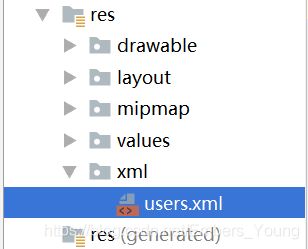Android入门之基本资源的使用(小白速成4)
之前略微提到过,可以将常用的属性定义在res中,颜色、字符、格式等也可以这样。
常用颜色设置
如在values文件夹下新建一个颜色文档,里面这样写:
<resources>
<color name="colorPrimary">#008577color>
<color name="colorPrimaryDark">#00574Bcolor>
<color name="colorAccent">#D81B60color>
<color name="text_color">#ff0000color>
<color name="bg_color">#00ff00color>
resources>
我们就可以将较常使用的颜色赋予名字,更为方便调用
调用也分为两种方式,代码方式和参数方式
下面我们看调用代码:
public void test(View view){
int color =this.getResources().getColor(R.color.bg_color);//获得颜色
Toast.makeText(this,""+color,Toast.LENGTH_SHORT).show();//或者在main中TextView 写android:textColor="@color/text_color"
this.getWindow().setBackgroundDrawableResource(R.color.bg_color);
}
代码方式我们可以用getResources() 方法获得我们定义的颜色,并且更改文字或者背景颜色。而参数方式,我们只需像注释中写的那样,增加textColor属性。
常用字符串设置
如同颜色一样,我们也需要在values文件夹下的string文件中自定义我们的字符串:
<resources>
<string name="app_name">test_colorstring>
<string name="yyj">你好,我是Embersstring>>
resources>
实际使用的时候,可以通过这样的格式:
android:text="@string/yyj"
我们就可以给文本赋予提前定义好的值
而在代码中:
public void test2(View view){
String str =this.getString(R.string.yyj);
Toast.makeText(this,str,Toast.LENGTH_SHORT).show();
Button button=findViewById(R.id.button2);
button.setText(R.string.yyj);
}
我们一般通过R.string.名字来寻找我们的字符串。
而上面代码是两种方式,第一种是先拿到再使用,第二种是直接使用。这两种都比较方便。
尺寸资源的设置
也就是我们对于长宽高的定义
px是像素
in是英寸
dp是和密度无关的像素
sp是和精度无关的像素
大家可以自行测试
<resources>
<dimen name="text_width">150pxdimen>
<dimen name="text_height">100pxdimen>
<dimen name="button_width">30mmdimen>
<dimen name="button_height">10mmdimen>
resources>
同样是定义这样的尺寸属性,在我们的values文件夹下。
android:width="@dimen/button_width"
android:height="@dimen/button_height"
直接使用如上所示
代码使用如下所示
public void test3(View view){
Button button =findViewById(R.id.button3);
float width =this.getResources().getDimension(R.dimen.text_width);
float height =this.getResources().getDimension(R.dimen.button_height);
button.setWidth((int)width);
button.setHeight((int)height);
}
xml资源的设置
我们可以在res文件夹下定义xml文件夹,存放我们需要的xml资源

xml文件中存放需要的数据,例如:
<resources>
user>
user>
resources>
具体的调用如下:
public void test(View view) throws XmlPullParserException, IOException {
String text ="";
XmlResourceParser xrp=this.getResources().getXml(R.xml.users);
while(xrp.getEventType()!=XmlResourceParser.END_DOCUMENT){
if(xrp.getEventType()==XmlResourceParser.START_TAG){
String tagname =xrp.getName();
if(tagname.equals("user")){
String uname=xrp.getAttributeValue(0);
String phone=xrp.getAttributeValue(1);
text+="name:"+uname+";"+phone+";\n";
}
}
xrp.next();
}
TextView textView =(TextView) findViewById(R.id.textView);
textView.setText(text);
}
图片资源的设置
图片资源也是存放在res中的drawable中,要特别注意图片不能以数字开头。

具体调用代码如下:实现了按不同按钮更换背景的操作。
public void test1(View view){
Drawable drawable=this.getResources().getDrawable(R.drawable.a1);
this.getWindow().setBackgroundDrawable(drawable);
//也可以在
}
public void test2(View view){
Drawable drawable=this.getResources().getDrawable(R.drawable.a2);
this.getWindow().setBackgroundDrawable(drawable);
}
以上就是所有常见资源的使用。
觉得有用的话记得点个赞呐!!
参考自:尚学堂课